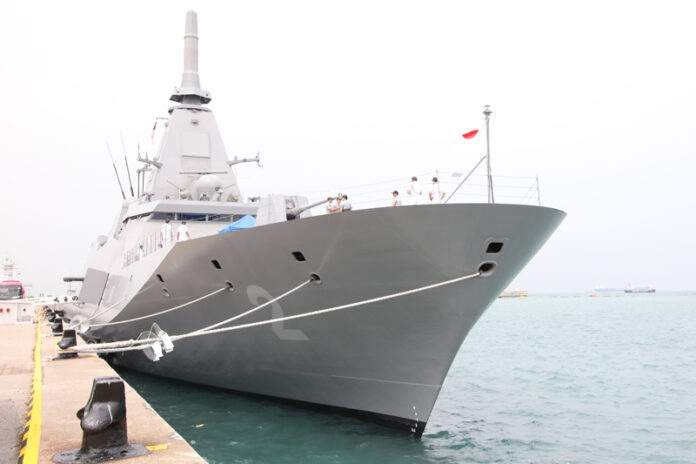It has been nearly ten years since Tokyo loosened regulations regarding the export of military equipment, and one of the foremost companies from Japan actively promoting its wares is Mitsubishi Heavy Industries (MHI).
In April, the Japan Maritime Self-Defense Force (JMSDF) dispatched its 30FFM-class frigate JS Kumano overseas for the first time, and one stop on its itinerary was LIMA 2023. MHI was contracted by the Acquisition, Technology & Logistics Agency (ATLA) to design and build these 3,900-tonne frigates, although JS Kumano’s construction was actually subcontracted to Mitsui E&S Shipbuilding. The vessel was commissioned on 22 March 2022.
Confronted by recruitment issues amidst an ageing population, these 132.5 metre-long frigates manned by 90 crew represent a significant departure for the JMSDF from its usual destroyer platforms.
Asian Military Review spoke to JS Kumano’s commanding officer, Commander Sakurai Atushi, who said the warship was “operating normally and is fully mission capable without any problems”. He continued, “While the size of the ship is slightly smaller than a destroyer, the required crew number is greatly reduced owing to automated and integrated systems.”
Significantly, the 30FFM can both lay and hunt mines. To perform the latter task, each frigate is equipped with an OZZ-5 unmanned underwater vehicle from MHI, as well as an 11m-long unmanned surface vessel (USV) from Japan Marine United (JMU).
The USV is stowed in a stern multi-mission bay beneath the hangar deck, and it is automatically launched/recovered. JS Kumano was not carrying a USV during its deployment to Southeast Asia but, from 11-13 May, the first-of-class JS Mogami performed trials with its OZZ-5 and USV in Japanese waters.
Cdr Sakurai pointed out: “Because of its anti-mine warfare capability, with the same speed and armament as a destroyer, FFMs are more effective vessels in mine countermeasure operations during mobile operations such as amphibious landings.” An important feature of the 30FFM is an integrated mast called the UNIted COmbined Radio aNtenna (UNICORN).
Originally, the JMSDF planned to induct 22 frigates at a rate of two annually till 2032, but Asian Military Review understands this plan has been altered to include twelve 30FFMs before transitioning to a class of ten follow-on frigates. MHI and JMU are vying to design the follow-on frigates, with proposals due in by 31 August.
With ATLA’s blessing, MHI is promoting its warships to friendly navies in the Asian region at events such as LIMA, and the 30FFM platform and associated variants is the first serious Japanese contender for export. Relatedly, an offshore patrol vessel for coast guards – displacing around 2,400 tonnes and measuring 100m long – was also on display at the Langkawi exhibition.
One other type being promoted at LIMA 2023 was a 160m-long multirole support ship. It can carry 500 troops, two landing craft and two helicopters. Malaysia is obviously one target, as the Royal Malaysian Navy requires such vessels under its 15-to-5 plan.
by Gordon Arthur, Langkawi













